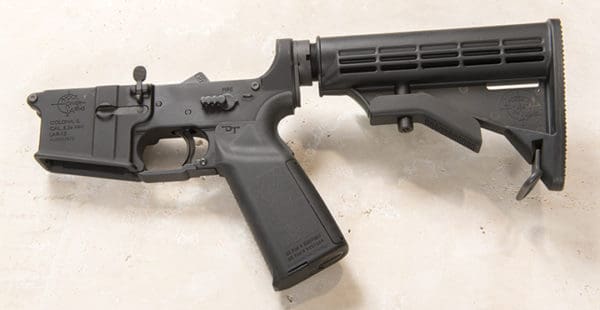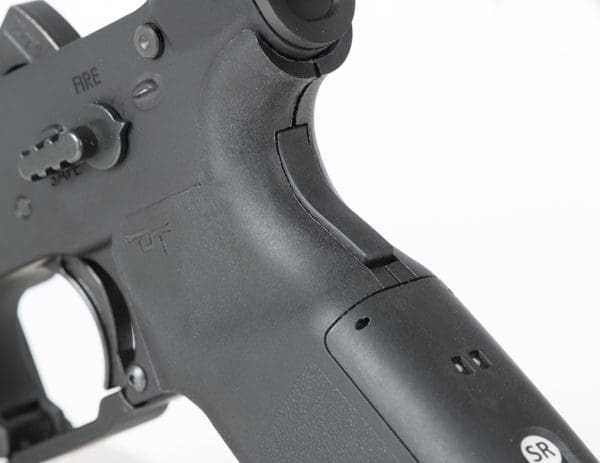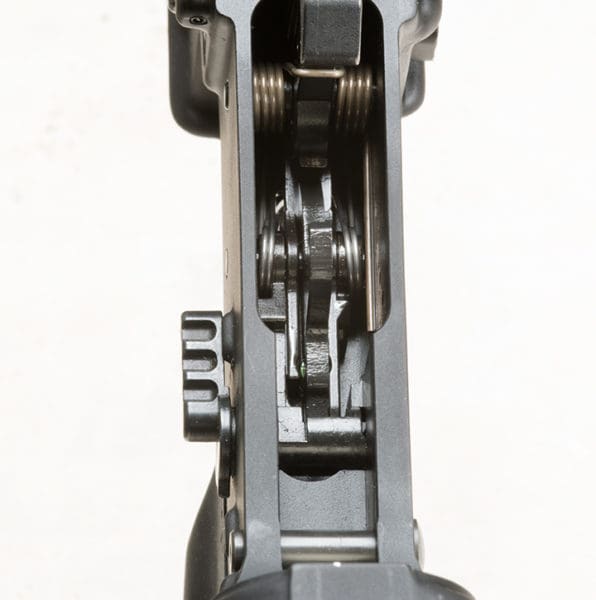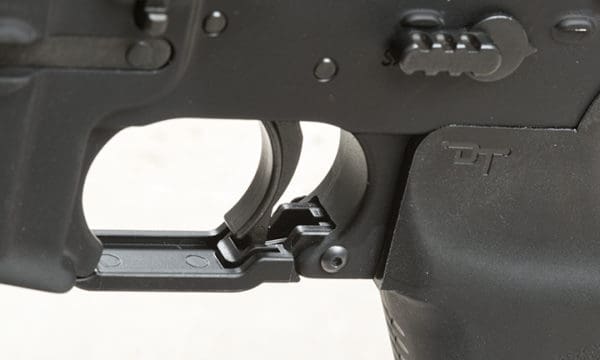
The less trigger weight required by the shooter, the less trigger travel, the smaller the chance of a bad trigger pull will ruin the shot. A one-pound trigger is perfect for precision shooting. When I first heard of the DigiTrigger I was excited. A one-pound trigger pull with little mechanical input. What’s not to love?
DigiTrigger requires a battery. Batteries and electronic components are never a good mix with guns and recoil. Further research revealed that the DigiTrigger is in “mechanical mode” when the selector’s set to the normal fire position. So the rifle will still shoot if the DigiTrigger’s battery or electronics fail. Whew!

The Digitriggers’ safe position and fire position work as a normal, mechanical trigger. To turn the digital system on, you rotate the selector to the traditional, full-auto location. This does NOT make it full-auto; it simply activates the digital trigger.
DigiTrigger comes in two flavors. The 1.1 runs $499 and you can have the 1.2 for $599. The number after the decimal point reflects the number of buttons on the backstrap of the grip. Both triggers work the same way. The upgraded model offers a binary fire mode: one shot when you pull the trigger, one shot when you release the trigger.

Both version include a grip safety. Grip safety “on” and “off” options are available on both version of the triggers. The 1.2 version offers a “Pull and Release” option which turns the DigiTrigger to a binary trigger.
In binary mode, if you don’t want to shoot the second round, you have three options to abort. After the first shot, hold the trigger back for at least six seconds. Alternatively, remove your hand from the grip safety, then release the trigger. Or press the PR button.
This is the most awkward of the three; the company recommends the first two methods as primary. Regardless of which process you use, it is VITAL to keep the rifle pointed in a safe direction during the entire process.

The bottom button on the pistol grip’s backstrap — marked “PR” — activates/deactivates the “Pull and Release” mode. The first push turns on the function. The red LED blinks three times. Push it a second time and it turns “Push and Release” off. The green LED flashes to indicate it’s off. [ED: red – green color blind shooters be damned.]
The top button on the backstrap of the pistol grip — marked “SR” — turns the grip safety on or off. The first press deactivates the grip safety. The red indicator flashes three times. Press the SR button again and the green LED flashes three times, telling you grip safety is on. (I would have labeled this button “GS” for grip safety, but that’s just me.)
The LEDs don’t stay lit; there is no indication of the system’s status as to the status. There’s only way to know if the grip safety is deactivated or if the trigger system is in single or binary mode: pull the trigger. “Yikes!” you say? All is not lost. The electronic trigger actuates regardless of the hammer position.

If the hammer is forward on an empty chamber, there’s no problem pulling the trigger to test status. Don’t forget the keep the muzzle pointed in a safe direction, even on an “empty” chamber. Otherwise, simply rotate the system off and on again with the selector. It will reset both settings to their primary function of a single trigger with the grip safety on.


The system runs on a single, nine-volt battery. DigiTrigger recommends Duracell, and nothing but. It installs easily in the base of the grip. A rotating plate holds the battery cover securely in place.
DigiTrigger says the battery lasts 1000 rounds. Yes, well, that’s only true if you remove the battery after shooting. I played with my DigitTrigger-equipped AR for about 30 dry fires, picked it up three days later and found that the hammer wouldn’t release. The battery had enough juice to actuate the electronics, but not enough to release the hammer. (The company says an updated board will enable long-term battery storage.)


DigiTrigger sent me a complete lower assembly for testing. The grip’s large. Larger than milspec, but no so large as to be uncomfortable. The trigger was easily reachable. The grip’s finish is matte, but very smooth. Too slippery for my tastes, but nothing some grip spray or grip tape won’t solve.


Pulling the DigiTrigger gently and smoothly, it feels like a very short, two-stage trigger. There is about 1/8-inch take up and about the same in trigger travel. There’s no mechanical friction; it feels like pulling against a light spring.
In the traditional fire mode, the milspec trigger felt like, well, a milspec trigger. The company promises that future versions will offer a plated trigger system to make the mechanical pull smoother than standard milspec.
While the electronic trigger pull is just one pound, the force required to release the hammer remains at milsepec weight of five to seven pounds. This makes the rifle drop safe. It’s a big advantage over lightweight mechanical triggers.
The 1.2 DigiTrigger offers binary trigger capability for rapid fire fun. But my primary interest is precision shooting. So I grabbed my most accurate upper, a LaRue Tactical Stealth, and headed for the range. As expected, the one pound pull enabled a clean trigger pull due to its very low weight.
If you shoot the DigiTrigger as a two-stage trigger, you have to go very slowly. It’s easy to travel through the take up and fire the round. It’s also important to hold the trigger back after each shot, as you would normally do in precision shooting. Otherwise the recoil makes it easy to double tap. Or more. Bump fire is only fun when you plan on bump-firing!
I didn’t like using the DigiTrigger for running close quarters shooting-while-moving drills. A slight bump of your finger will set it off — one of the reasons that combat triggers are not one pound. Additional practice would help ameliorate the problem, but not to the point of safety.
The binary trigger is a blast. This was my first experience shooting binary; having a shot fire when you release the trigger is a little disconcerting a first. Once I got used to it, rapid fire was easy. And fun. Yes, lots of fun. And expensive. Very expensive.
[It’s worth noting that the binary trigger is not CA-legal but it is ATF approved. DigiTrugger’s website has a determination letter stating that binary triggers are legal. They also have a determination letter stating that fly by wire (electronic) triggers are legal.]



Bad news: DigiTriggers are not user installable. “To ensure reliable and safe function” you have to ship a complete lower to the factory or one of their dealers. At the time of writing, there are 15 dealers (and counting) that will install the device. The factory can accept SBRs and the dealers may be able to, as well, depending on their licenses.
The lower must be milspec and have a removable trigger guard; the DigiTrigger utilizes a proprietary trigger guard as part of their system. AR10-pattern lowers will work as well. The factory or dealer replaces the customer’s trigger, hammer, disconnector, selector, selector detent, trigger guard and grip with the DigiTrigger’s parts.
The LEO and military-only DigiTrigger 1.6 will have both semi- and full-auto mechanical modes. The digital mode will offer two-shot burst, three-shot burst, full auto. Users will be able to adjust the rate of fire as well to 5, 10 and 20 shots per second.
DigiTrigger also offers lower assemblies and complete rifles. The lower assembly consist of a Rock River Arms LAR-15 lower and basic collapsible stock. It comes equipped with either the 1.1 trigger ($799) or the 1.2 trigger ($899). You can also buy a complete Ruger AR-556 for $1199 (with the 1.1 trigger) or $1299 (with the 1.2.)
The DigiTrigger is a genuine advance in firearms technology. It’s fun and, crucially, increases precision shooting accuracy. With the forthcoming improvement in battery life, the DigiTrigger will be a perfect addition to any shooter’s arsenal.
RATINGS
Trigger pull * * * *
One a scale of one to five, I rate the digital trigger a 10. The mechanical trigger rates an “meh.” That’s milspec for ya. So call it four stars.
Ergonomics * * * * *
The grip was bigger and feels different than a milspec grip, but that’s to be expected since the DigiTrigger grip is filled with a battery and lots of electrons scattering about. Still feels fine in the hand and the trigger is easily reachable, even for small hands.
Utility * * * * *
A pound trigger is ideal for precision shooting and the binary mode is a lot of fun.
Overall****1/2
The Digitrigger is useful for long-range shooters, and a whole lot of fun besides. When the battery drainage issue is solved, it will be damn near irresistible.




Sounds like a fun little idea, but a bit outside my budget. Maybe future versions will improve price and battery life- I could be interested then!
So. Anybody want to take bets on how long it will take for the ATF to have a whole ranch after somebody hacks a 1.2 to function like a 1.6?
I smell jail (for the geeky criminal) and confiscation for the poor suckers who bought this thing. They better have good security on the embedded ROM.
Hacking will be completely unnecessary.
A one-pound trigger on a centerfire semi-auto rifle is going to bump-fire under most normal bench/bipod-supported positions, unless the operator takes very specific steps to prevent it. Any firing from a bipod with less than a VERY firm grip on the pistol grip will cause a repetitive rebound off the shoulder that will closely mimic FA fire.
I’ve fired several ARs with 2-2.5-pound single-stage triggers from different bipod-supported positions, and when using a support-hand-under-the-stock position, you have to concentrate to NOT burp the entire mag downrange. After installing a light single-stage trigger, my heavy-barreled AR varminter showered the range user to my right with a burst of hot brass when I tried to fire a fouling shot out of a 10-shot mag prior to checking zero; I was apologetic, but he was not amused. I eventually removed the light trigger, and converted to 2-stage triggers for most AR uses, as the long slack/take-up in that design helps prevent unintended bump firing.
Based on my experience, a one-pound single-stage AR trigger borders on the irresponsible.
*Exactly* what I was thinking.
It would be no problem to feed that thing a pulse train and have it rock-n-roll ’till the ammo runs dry.
The next hack after that will be variable speed. A 555 timer, caps and resistors for an R-C network and a potentiometer and off you go.
Slow-speed to make it sound like an Ma Deuce, fast for that German WW2 buzz-gun.
Ammunition companies will have you on their Christmas card list…
Hacking the Digitrigger would be no different than adding a auto sear to a AR15. Both are highly illegal.
Only if you recognize the NFA as a valid law. Given SCotUS precedent on the matter, I do not. Similarly, there is precedent about the need to obey an unconstitutional law, more or less the same as obeying an illegal order. (Hint: you don’t.)
So why don’t you install an auto-sear on an unregistered rifle, walk into the BATF, slap the secretary across her face with your dick, throw the rifle down, and ask ’em what they think about them apples?
Because I’m not looking to start a firefight? On the plus side, when the left finally rises in open insurrection, they may be surprised by just how many people happen to have odd spare parts lying around for their weapons.
Geeze! Like to see that on YouTube (with appropriate fuzz out of said dick)!
“Both are highly illegal.”
Absolutely correct, Rabbi. 10 years in ‘Club Fed’ if one is caught.
If I had access to the PCB, I bet I could make it sing and in a way that would leave no incriminating marks on the board. (Pressure contacts)
Hypothetically speaking, of course. *cough*. 😉
Hack? No need. Simply pull out their board and replace with your own. No need to try to figure out their electronics. You could make it do whatever you want, all you need to be able to do is detect trigger position (using their sensor) and provide a signal to the electronically activated sear.
Hell, before long some enterprising soul (soon to be felon) will have one rigged up with their own board with Bluetooth (or some other wireless protocol) so they can really play with it.
That’s a negative
it comes with a “diddle” mode?
way too cool.
diddle, diddle diddle!
We all know no military or police organization is going to use this. Anyone else sick of promotional videos that seem to indicate its a battlefield component? Good grief. Also, nothing like installing a VFG then not using it to fire. Ok I guess.
DigiTrigger does not have a determination letter on their website. They just have some old letters applied to other products.
On the military version – 20 rounds per second seems like a tall order for a platform that normally won’t shoot that fast in full auto.
Probably works similar to the electronic triggers on paintball guns. They just click the sear as fast as they can, waiting for the bolt to catch. If it’s not there, it’ll release on the next click. I suppose the same could be done with the hammer in an AR, but it’ll probably just ride the bolt and not fire.
On a full-auto AR-15 the hammer is released by the bolt carrier when it locks into battery. So I don’t know how some electronic system is going to do that faster.
Excellent point.
They might be able to make is hit that number if it was on a blowback pistol-caliber AR carbine set up to have a shorter bolt travel, but otherwise, you’re spot-on.
A solution in search of a problem?
Not at all. The light pull weight and short pull of the Digitrigger is perfect for precision shooting. It is unmatched in the AR world. The other features are just cherries on top
I can understand the very low pull weight but it seems unnecessarily complex to acheive that, plus the electronic components and their associated issues.
So it’s just a paintball fun digital trigger? Looks easy enough to retrofit new modes.
No thank you, this is one step closer to a so called ‘smart gun’ (i.e trigger can only be operated after the swipe of a thumb print or similar) thereby kicking in NJ’s law.
There are plenty of excellent drop in AR triggers available if you want precision.
It’s a “no” for me. Mechanical mode as a backup or not, I really don’t want electronics of any kind in any of my firearms. I’ve seen too much weird sh!t with all kinds of electronic gadgetry. But, each to his own.
“…I really don’t want electronics of any kind in any of my firearms.”
They can have their place. Most modern weapon lights are electronic, selectable power levels, etc.
I can see a red dot, as long as I have a co-witness backup iron sight. Lasers as well for aiming.
“But, each to his own.”
Yep! It’s a free country (barely!)… 🙂
As a EE turned gunsmith, I couldn’t agree more.
I like the idea binary triggers, but it reminds me how bad the FING (New Jersey Democrat William Hughes) Hughes Amendment is, and how stupid the ATF is in regulating full-auto firearms while allowing binary triggers (a distinction without an fing difference if you’re paying the slightest attention to logic) I’d rather spend the $$$ on getting it repealed.
Speaking of the $$$. Half of the purchase price is going to the idiots who produced that cheesy commercial.
“Digital / Solid State” triggers are just a half step to smart-gun technology.
You say that like it’s a bad thing.
“Smart gun” technology is best left to the marketplace. The market will decide if it’s good or bad. And personally I have no problem with an electronic trigger that reverts to traditional mechanical mode in the event of a power failure.
A binary trigger is somewhat akin to the release triggers used by many trap shooters (including me). Once you pull it, things can get dangerous. Be careful out there.
The only work I do on release triggers in shotguns is to remove them.
I want no part of any future legal case of a negligent discharge where I’m being interrogated by lawyers why there was a release trigger in a gun, why the trigger works backwards from almost every other trigger in the market, and who thought this was a brilliant idea to put into a gun.
So I won’t install, service or adjust release triggers. The only service I offer is to remove them. And I’ve removed a few…
“You say that like it’s a bad thing.” – Curtis you say that like it’s a good thing.
NO. If the “Market” were to decide, I’d have 2-3 full auto AR’s and a Polish RAK, some real 40MM for my M203, and maybe a claymore for a pillow.
B. FING S.
We have bullshit dictatorial POS (D) and rinos that’ll say “great, now that we have the technology to do electronic triggers, ALL guns need to have them, and don’t bother trying to make them hybrid-mechanical”.
F ALL THAT
So, you want to tell me that I can’t buy something I want – or, that I must buy something I don’t want.
Like, health insurance?
I would never handle one of these things unless the grip safety was a mechanical interlock, and from the description, that does not appear to be the case. All electronic systems are inherently unsafe unless they are designed from the ground up to fail in a safe manner under all possible failure modes. If they can’t even keep the battery charged, I doubt this particular item meets that criteria.
My question is who is really using a semi auto for true precision shooting? Bolt guns reign supreme there. IMHO needing a rapid follow up shot is not a circumstance of true precision.
So add in the fanalgalry of the new manual of arms and the inherent unreliablity of electronics under mechanical stress and you are left with a very solid “solution in search of a problem.”
Now change the marketing to Hughes legal giggle switch and I am a happy customer. (Well after I leave Can that is)
How weather-proof is this? Electronics and wet environments are not usually a good combination.
Digital Trigger, what happens when it gets wet. I see no water resistant rating. No test stack in extreme cold. I mean I’m interested in buying a Digital Trigge but I like to know these things before I buy one.
Be careful; when you get a kit you’ll be missing a part which will render such useless and a huge time/money suck.
Larry again… made a mistake; my friend told me all parts included.